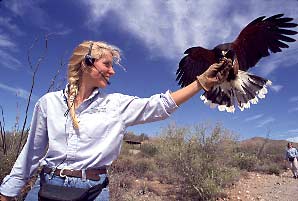
Southern Arizona is a popular winter destination for many good reasons, mild temperatures and golf among them. But the area is also a naturalist's paradise. Perhaps because the desert environment is so demanding, the plants and animals that have adapted to it are all the more intriguing.
The single best place to experience and learn about the desert is the Arizona-Sonora Desert Museum, near Tucson. It is no ordinary museum filled with specimens. In fact, this combination zoo, natural history museum, and botanical garden contains more than 300 kinds of animals and more than 1,200 kinds of plants at home in their native habitats. After a day here, you'll never again think of the desert as an empty place with nothing but cactus.
Travel and Leisure magazine ranks the 21-acre museum among America's top 10 zoos, along with the Bronx Zoo in New York and the San Diego Zoological Park. The New York Times calls the desert museum "one of a kind ... not to be missed." Peak season for a visit is December through April, when the desert is pleasantly warm, not searingly hot.
The private, nonprofit museum was founded in 1952 by naturalist William Carr and conservationist Arthur Pack, a former editor of Nature magazine. With the American Museum of Natural History in New York, Carr had earlier founded the Bear Mountain Trailside Museum, today a part of Iona Island National Estuarine Research Reserve, Stony Point, New York. Carr took the Iona Island experience, which focused on native plants and animals, and headed West.
The popular symbol of the desert, the saguaro cactus, doesn't grow everywhere in the Southwest. But it does thrive in the Tucson area, and the western portion of Saguaro National Park is adjacent to the museum. These magnificient plants, some of them 200 years old and up to 50 feet tall, are reason enough to visit the museum.
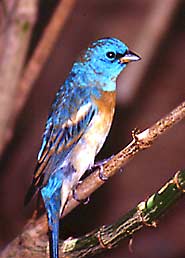
Highlights for bird-watchers
It's personal preference of course, but I always head first to the walk-in aviary, home to some 40 birds that are native to the Sonoran Desert. It was here I first saw a Gambel's quail and a magnificent sparrow-sized hummingbird, and the irridescent lazuli bunting, pictured at right.
In a separate hummingbird aviary live eight kinds of small hummingbirds, from the tiny but formidable rufous to the finch-sized Anna's to the brilliantly colored Costa's. Rufous hummingbirds are the migration champions of the bird world, each year completing the round trip between Alaska and Oaxaca, Mexico.
But bird-watchers can enjoy the entire garden because native species such as cactus wrens and gila woodpeckers make their homes and find their dinners in the gardens, just as they might anywhere in the desert. Compared to birds in the wild, these birds seem a little more comfortable around people, meaning that you are much more likely to get close for a good view.
Througout the winter months of November through April there are daily raptor free flight demonstrations on the desert loop trail (see top photo). The museum emphasizes that the demonstration is an opportunity to see raptor behavior up close: it's not a bird show. Photographers can even make arrangements ahead for special sessions with a raptor specialist.
Lizards, scorpions, snakes, tarantulas, and other desert creatures are also well represented. If a museum docent is available, you might even get to pet a tarantula, a memorable experience for kids, and maybe adults, too.
Altogether, 17 displays focus on different aspects of desert life. You'll see animals common to many regions of the West such as bighorn sheep, as well as desert specialists such as chuckwalla and Gila monster (lizards), coati (a raccoon relative), jaguarundi (wildcat), and javelina (a wild boar relative).
Photographers, both professional and amateur, are drawn to the opportunities for one-of-a-kind shots. Watching them work may give you tips on how best to capture the plants and animals with your own camera.
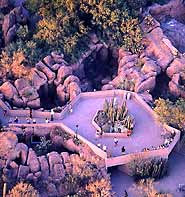
Walking the trails
The museum's 2 miles of trails let you make your own discoveries. So much of the garden is open to wild birds and animals, you never know what you will see, but January and February are good months to look for phainopeplas -- glossy-black tropical birds that roost in mesquite trees this time of year.
A scenic overlook (photo at left), just to the right of the museum entrance, offers a 60-mile view over the Avra Valley west toward the Tohono'odham Indian Reservation and south beyond the Mexican border. Saguaro cacti are the view's most prominent feature.
Beyond the walk-in aviary, the Riparian Corridor is a cool alternative to the open desert in most of the park. Lush growth, including cottonwoods, and a stream harbor river otters and beaver.
Other areas focus on additional desert habitats, including mountain woodland, desert grassland, cactus, desert plant, and wildcat. Of particular interest are the new pollination gardens.
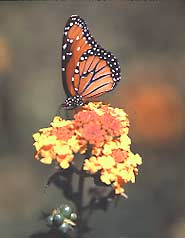
Flower power to the pollinators
Just to the left of the entrance, seven Pollination Gardens, dedicated less than a year ago, were designed to attract and support specific migratory pollinators: bats, bees, butterflies, hummingbirds, milkweed, moths and yucca moths. I particularly enjoyed the bee garden, because it tells about the solitary and other lesser-known bees, and how to encourage them to visit your own garden.
In the garden, a "bee condo" is perfect for attracting native leaf-cutting and mason bees. It's just a heavy post drilled with 1/8- to 5/16-inch holes and protected from sun and rain -- an idea worth bringing home.
About 225 species of flowering plants attract various migratory pollinators. Last year, these gardens served as the backdrop when biologists from Mexico and the United States gathered to discuss and initiate studies of the migratory corridor the two countries share.
According to Gary Nabhan, the museum's director of conservation and science, "We can thank a pollinator for every third bite of food we eat." Considering our dependence on pollinators, and the fact that, according to Nabhan, "there are fewer domestic honeybees in North America than at any other moment in our lifetimes," the need to learn more is well founded.
Paying for pollination
Flowers use color, fragrance, pattern, and shape to attract bees, birds, and other pollinators. But these creatures don't care about plant reproduction--they want a meal. Each blossom offers just enough nectar and pollen to make it worth visiting, so the hungry pollinators must hurry from flower to flower in order to get enough to eat, a process that ensures plenty of pollen gets passed around. In effect, plants are using their nectar and pollen to pay for pollination.
Funding for both the pollination gardens and a long-term study of migratory pollinators -- which also include white-winged doves, lesser long-nosed bats, rufous hummingbirds, and monarch butterflie s-- comes from the Turner Foundation and Turner Endangered Species Fund. Participating institutions include the Universities of Arizona and Miami, and the Universidad Nacional Autonoma de Mexico.
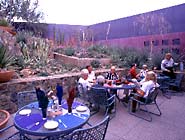
Practical details
It's easy to spend a full day walking the trails, especially if you enjoy photographing the plants and animals you see along the way. While there are ramadas (shade structures) and even underground displays, you'll mostly be outside, usually in full sun. Wear a hat and sunscreen, not to mention comfortable shoes. There are a number of paved trails that are wheelchair accessible.
You'll find several drinking fountains, two restaurants, a coffee bar, and a snack bar. The Ocotillo Cafe features full-service dining in elegant indoor and patio settings. From December to April, it's open for lunch from 11 a.m. to 2 p.m. daily. During the rest of the year, the Ocotillo serves a Sunday brunch from 10:30 a.m. to 2 p.m. The less formal Ironwood Terraces are open 10 a.m. to 4 p.m. daily, and Phoebe's Coffee Bar is open daily during museum hours.
Winter hours are 8:30 a.m. to 5 p.m. daily (7:30 a.m. to 6 p.m. March through September). Admission costs $9.95 for ages 13 and over, $1.75 for ages 6 through 12. Museum members and ages under 6 are admitted free.
The museum, at 2021 North Kinney Road, is 14 miles west of downtown Tucson. From Interstate 10, take Speedway Boulevard west; at Camino de Oeste, Speedway becomes Gates Pass Road, then Kinney Road. From there, follow the signs to the museum. From downtown Phoenix, it's a 2-hour drive southeast on Interstate 10; exit west at Speedway Boulevard.
For more information, call (520) 883-1380, or see the museum's Web site.
Michael MacCaskey is a former editorial director of National Gardening.
Photography by: Adriel Heisey (top); Michael MaCaskey (lazuli bunting); all others Paul Berquist